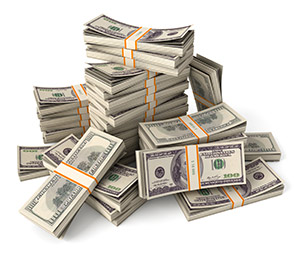Cash isn't the most exciting or dramatic asset you can hold, but, aside from gold itself, there's not much that's more vital or versatile - especially right now.
Here's why...
First, if you have cash, you can buy those distressed assets that have to be sold by overleveraged owners when they're forced to sell. In this way, when things go wrong, you're a "liquidity provider," much like Warren Buffett who famously made some of the best, most favorable deals of his entire life in the crisis years of 2008 and 2009. Buffett pulled off this coup by being flush with cash when hardly anyone else was.
Cash also tends to hold its own against assets that are inflated by high levels of debt, like real estate and stocks are right now. It tends to depreciate against gold, but it will do much better than overpriced financial assets like stocks when the dam breaks.
And of course, if things finally get so bad that even CNBC or Barron's admit as much, you can use cash to buy items essential to survival, like food, water, and a complete set of "The X-Files" Blu-ray discs.
So I want to show you an unbeatable cash strategy right now. You'll see how much cash to hold at any one time, and just as important, how to hold it; there's more to "cash" than pictures of dead presidents.
But in order to get all the advantages that a right-sized cash position offers, you have to understand why the dollar is strong and getting stronger...
The U.S. Dollar Is the Oxygen of the Global Economy
Everyone takes it for granted, but the "almighty dollar" determines the value of every single financial instrument in the world - stocks, bonds, commodities, real estate, art, collectibles, you name it.
So when the value of the dollar changes significantly against other currencies, it causes the value of these assets to change as well.
And that is exactly what started to happen in June 2014, and why the dollar is strong and will likely keep growing stronger.
The value of the dollar is driven by monetary policy, which is set by central banks around the world. Central banks set policies that affect their interest rates and the value of their currencies.
For example, if the U.S. Federal Reserve lowers interest rates directly (by lowering the federal funds rate) or indirectly (through QE), it lowers the value of the dollar because investors holding dollars will earn a lower interest rate on their dollars. In contrast, if the Federal Reserve raises interest rates (directly or indirectly), it raises the value of the dollar. The same applies to other central banks - if they take actions to raise or lower the interest rate paid on their currencies, the value of those currencies respond accordingly.
Sometimes different central banks act together or in concert to lower interest rates and sometimes they don't.
Right now we are in a period in which the Federal Reserve and other major central banks in Europe, Japan, and China are not only not coordinating their actions, but are often working at cross purposes, which has enormous consequences for the dollar.
And in turn, what happens to the value of the dollar has enormous consequences for other financial assets.
Let me show you a way you can track the relative strength of the dollar to determine whether you have enough cash. You can also use it to see what's coming next in the global economy.
Get to Know the U.S. Dollar Index
The U.S. Dollar Index (DXY) is an index that measures the value of the dollar relative to a basket of foreign currencies. The composition of the index is euro (57.8%), yen (13.6%), British pound (11.9%), Canadian dollar (9.1%), Swedish krona (4.2%), and Swiss franc (3.6%). As you can see, 70% of the index is tied to just two currencies - the euro and the yen.
 The DXY has been trading between 91 and 100 for the past 12 months, and in overall "rally mode" since 2014, when it started moving up sharply.
The DXY has been trading between 91 and 100 for the past 12 months, and in overall "rally mode" since 2014, when it started moving up sharply.
Keep an eye on the DXY - as of July 2016, it's above 96 and likely to move higher, which would have massive deflationary consequences for global markets.
The reasons for this sharp rally go back to the markets' reaction to the closing days of quantitative easing in the United States, back in October 2014. The markets began anticipating this a few months before that happened.
At the same time, investors began expecting the European Central Bank and the Bank of Japan, which are responsible for setting interest rates on the euro and the yen, respectively, to move in the opposite direction. The European and Japanese economies were struggling and needed stimulus.
And sure enough, on Oct. 31, 2014, the Bank of Japan, along with Japan's largest pension fund, the Government Pension Investment Fund, announced a massive QE program that included not only massive purchases of Japanese Government Bonds (JGBs - the equivalent of U.S. Treasuries) but also stocks and exchange-traded funds (ETFs).
Then Mario Draghi's European Central Bank caught stimulus fever with its first QE program in January 2015.
The euro, which had already started to weaken against the dollar - from the $1.40 range in early 2014 to $1.21 on Dec. 31, 2014 - plunged on this news to as low as $1.05 during the first quarter of 2015. It has since settled at either side of $1.10 (with some technical spikes higher).
This is a classic case of important global central banks not coordinating policy.
While the Fed has ended quantitative easing and began raising interest rates at the end of 2015, the ECB and the Bank of Japan are still moving in the opposite direction, initiating huge new bond-buying programs to lower interest rates in their markets.
That means Europe and Japan are dead set on cheapening their currencies against the dollar. As a result, the U.S. dollar will keep rising as global investors flee lower-yielding currencies and make a "flight" to the higher-yielding U.S. currency.
That should push the dollar upward and further depress the euro and yen, and for the foreseeable future, too.
And that means it's time to increase your cash holdings.
Here's What I Tell My High-Net-Worth Clients
My suggested portfolio is 10% to 20% cash. Incidentally, that's the exact same amount I allot to gold, so you know I'm a cash fan.
But "cash" is about much more than pictures of dead presidents. As equivalents, the securities I'm about to show you are even safer than a bank account.
They're extremely liquid, and I prefer them to banknotes because when you hold cash at a bank or a brokerage firm, you can become a general creditor if the firm goes bankrupt. But if you own these securities, you are a creditor of the U.S. government. That makes them virtually risk-free... at least for now.
Now, admittedly, they are low return (after all, there is no yield on cash these days), but still better than you'll get from the bank.
What's more, they're very, very safe. Think of it as "cash, but better."
My favorite "alternative" place to put cash is in one-month or three-month Treasury bills.
It's very important to note, these are not bonds. They're not notes. They are bills. Remember that this is not an "investment," but a sort of secure parking area.
Here's how they work.
Like I mentioned, you won't get a great return on T-bills because they're so exceptionally safe. They're considered virtually risk-free, and they're also exempt from state and local income taxes (though still subject to federal tax).
You buy them for less than the face value (also called the par amount) and then hold them until maturity, at which point you cash them in for the full value. So you might buy a $1,000 bill for $990 and then cash out for the full $1,000. If you cash out before maturity, obviously you don't get the full value.
If someone cashes out a bill before it's matured, there's some money left over, which you can bid for on the "secondary market."
You can ask your broker to help you with this, or you can do it yourself if you have a brokerage account with someone like Fidelity or Schwab.
The best part of a T-bill strategy is you don't have to do anything to redeem the bills. The government, believe it or not, takes care of it for you - it's one of the few times that's ever going to happen. On the day the bill matures, they deposit the proceeds into your indicated account of choice.
On the other hand, if you don't want to put your cash in the bank, you can simply set up your account to roll the proceeds into new bills of the same term and type next month. It's called reinvestment. You can schedule this action when you buy your initial bill, or wait until up to four days before it matures. You can reinvest like this, automatically, for up to two years.
Of course, banknotes and T-bills are far from the only cash strategy I'm recommending right now. Click here to get free access to my Cash Profit Playbook and you'll learn how to "juice" a normally low-return protective strategy for some serious gains, especially in these post-Brexit markets. You'll also get my Sure Money twice each week.
Follow Michael on Facebook and Twitter.
About the Author
Prominent money manager. Has built top-ranked credit and hedge funds, managed billions for institutional and high-net-worth clients. 29-year career.



